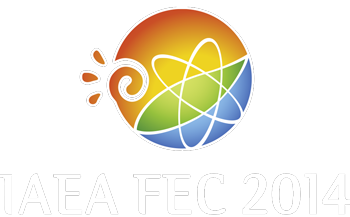Speaker
Dr
Ilya Senichenkov
(Saint Petersburg State Polytechnical University)
Description
In the present paper the results of integrated modeling of Globus-M tokamak plasma with the help of recently coupled core transport code ASTRA and edge transport code B2SOLPS are presented. In the modeling taken into account are the neoclassical transport, auxiliary heating and current drive by the NBI, 2D drift fluxes, currents and electric field in the edge plasma in a real geometry of magnetic flux surfaces and first wall constructions of a spherical tokamak. It is demonstrated that the modeling results are in a satisfactory agreement with laser and probe measurements and fast neutral particle analyzer and neutron analyzer signals for various plasma current values both in ohmically heated and NBI-heated discharges. The dependence of the scrape-off layer structure and the heat loads to the divertor targets on the plasma current and the discharge power is investigated. It is found that the heat flux decay length agrees with a predictions of the scaling [T.Eich et al., Phys.Rev.Lett., 107, 215001 (2011)] stemming from a large multi-machine experimental database. Thus this scaling passed through the tests versus experimental data from a small spherical tokamak with small magnetic field, plasma current and power, and the database is expanded correspondingly.
| Country or International Organisation | Russian Federation |
|---|---|
| Paper Number | TH/P1-35 |
Author
Dr
Ilya Senichenkov
(Saint Petersburg State Polytechnical University)
Co-authors
Ms
Alena Gogoleva
(Saint Petersburg State Polytechnical University)
Mrs
Elena Vekshina
(Saint Petersburg State Polytechnical University)
Dr
Elizaveta Kaveeva
(Saint Petersburg State Polytechnical University)
Mr
Georgii Zadvitskiy
(Saint Petersburg State Polytechnical University)
Dr
Nikolay Khromov
(Ioffe Institute)
Dr
Pavel Molchanov
(Saint Petersburg State Polytechnical University)
Mr
Sergey Lepikhov
(Ioffe Institute)
Dr
Sergey Voskoboynikov
(Saint Petersburg State Polytechnical University)
Dr
Vasily Gusev
(Ioffe Physical-Technical Institute)
Prof.
Vladimir Rozhansky
(St.Petersburg State Polytechnical University)

